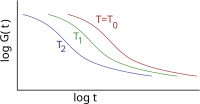
Photo from wikipedia
Fractional derivative and WLF equation are effective in describing the dynamic behavior and time-temperature effect of viscoelastic damping materials, respectively. These approaches have essentially evolved from the viscoelastic constitutive behavior.… Click to show full abstract
Fractional derivative and WLF equation are effective in describing the dynamic behavior and time-temperature effect of viscoelastic damping materials, respectively. These approaches have essentially evolved from the viscoelastic constitutive behavior. Based on such intrinsic relation, a fractional time-temperature superposition principle model (FTTSPM) that integrates the fractional constitutive relation and WLF equation was proposed. The parameters of this model were determined by performing tensile and DMA tests, and the master curves at 5 °C constructed by FTTSPM and WLF equation were compared. The theoretical prediction over the extended frequency span as the master curves was made by using the fractional standard linear solid model (FSLSM) to validate FTTSPM. The numerical results show that FTTSPM conforms to the time-temperature superposition principle. The parameters α and B′ in this model denote the impact of the material and environment on the shifted factor, respectively. For the storage and loss modulus, the extended frequency obtained by FTTSPM is broader than that obtained by the WLF equation. Moreover, the evaluation of the storage and loss modulus by FTTSPM is much closer to the theoretical prediction compared with that by the WLF equation. Therefore, FTTSPM is a concise and experiment-based approach with a higher precision and greater frequency-extended capacity compared with the WLF equation. However, FTTSPM inevitably faces a vertical shift when non-thermo-rheologically simple materials are considered. The physical mechanism and practical application of FTTSPM will be examined in further research.
Journal Title: Journal of Mechanical Science and Technology
Year Published: 2019
Link to full text (if available)
Share on Social Media: Sign Up to like & get
recommendations!